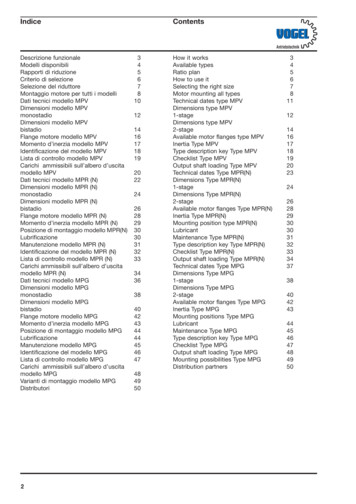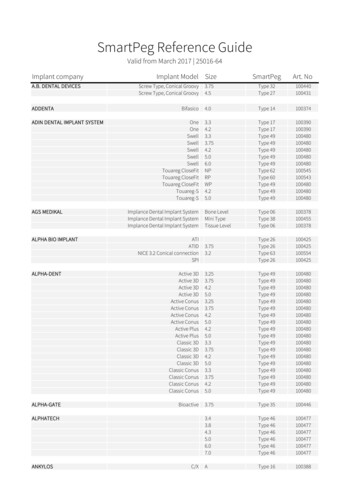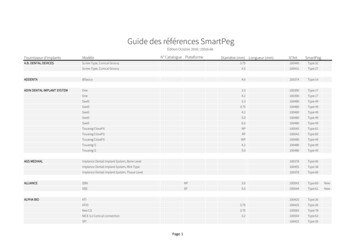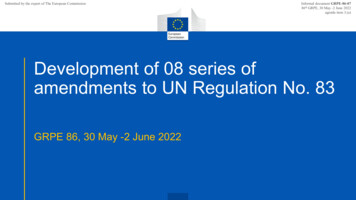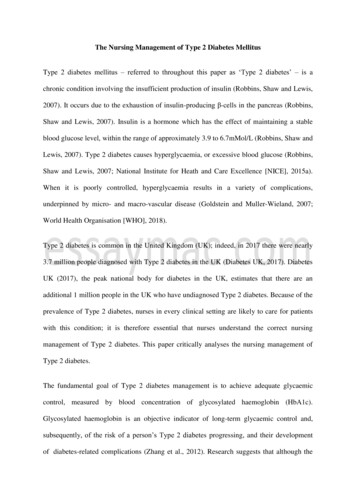
Transcription
The Nursing Management of Type 2 Diabetes MellitusType 2 diabetes mellitus – referred to throughout this paper as ‘Type 2 diabetes’ – is achronic condition involving the insufficient production of insulin (Robbins, Shaw and Lewis,2007). It occurs due to the exhaustion of insulin-producing β-cells in the pancreas (Robbins,Shaw and Lewis, 2007). Insulin is a hormone which has the effect of maintaining a stableblood glucose level, within the range of approximately 3.9 to 6.7mMol/L (Robbins, Shaw andLewis, 2007). Type 2 diabetes causes hyperglycaemia, or excessive blood glucose (Robbins,Shaw and Lewis, 2007; National Institute for Heath and Care Excellence [NICE], 2015a).When it is poorly controlled, hyperglycaemia results in a variety of complications,underpinned by micro- and macro-vascular disease (Goldstein and Muller-Wieland, 2007;World Health Organisation [WHO], 2018).Type 2 diabetes is common in the United Kingdom (UK); indeed, in 2017 there were nearly3.7 million people diagnosed with Type 2 diabetes in the UK (Diabetes UK, 2017). DiabetesUK (2017), the peak national body for diabetes in the UK, estimates that there are anadditional 1 million people in the UK who have undiagnosed Type 2 diabetes. Because of theprevalence of Type 2 diabetes, nurses in every clinical setting are likely to care for patientswith this condition; it is therefore essential that nurses understand the correct nursingmanagement of Type 2 diabetes. This paper critically analyses the nursing management ofType 2 diabetes.The fundamental goal of Type 2 diabetes management is to achieve adequate glycaemiccontrol, measured by blood concentration of glycosylated haemoglobin (HbA1c).Glycosylated haemoglobin is an objective indicator of long-term glycaemic control and,subsequently, of the risk of a person’s Type 2 diabetes progressing, and their developmentof diabetes-related complications (Zhang et al., 2012). Research suggests that although the
holistic, multidisciplinary management of a person with Type 2 diabetes is important, nurseshave a key role in Type 2 diabetes management, and particularly in relation to supporting aperson with Type 2 diabetes to achieve long-term glycaemic control (Richardson et al.,2014).There is a large volume of evidence about the effective nursing management of Type 2diabetes. Indeed, the Royal College of Nursing (RCN) identify no fewer than eleven discreteroles for nurses in relation to the nursing management of Type 2 diabetes. Ultimately,however, the literature advises nurses to follow the recommendations in the most currentNICE guidelines (Nair, 2007). For this reason, the strategies discussed here are based on theNICE (2015a) Type 2 Diabetes in Adults: Management guideline, the primary guideline forpractice in the UK.Strategy #1 – Patient education: The NICE (2015a) guideline recommends that all patientswith Type 2 diabetes are offered structured, evidence-based and resource-effective educationto enable their self-management of the condition. This education must focus on dietary advice(refer to Strategy #2 following), and also related lifestyle changes such as exercise for weightcontrol (Lawrence, Conrad and Moore, 2012). A recent systematic review and meta-analysisconcluded that nurse-led education for people with diabetes can improve glycaemic control toa statistically-significant degree, and that this improvement is often sustained over time(Tshiananga et al., 2011). However, currently there is a paucity of conclusive evidence aboutthe most effective design for patient education for Type 2 diabetes – including in terms offrequency and timing, delivery strategies and content (Tshiananga et al., 2011) – and nursesshould therefore be guided by local policies and / or those of their healthcare organisation.Strategy #2 – Dietary advice: Patient education, as outlined in Strategy #1 above, must focuson dietary advice, as dietary intake is the fundamental factor in the development and
management of Type 2 diabetes (Ley et al., 2014). The NICE (2015a) guideline emphasisesthe importance of providing ongoing, individualised dietary advice to people with Type 2diabetes, particularly in relation to the intake of high fibre, low glycaemic index (GI)carbohydrates. In addition to the types of foods people with Type 2 diabetes consume, nursesshould also provide advice about correct eating patterns to achieve glycaemic control:specifically, consuming three balanced meals plus appropriate between-meal snacks each day(Lawrence, Conrad and Moore, 2012). Although nurses have “expertise and responsibility” inrelation to dietary intake (Xu et al., 2017), they are required to refer to a dietician ornutritionist if a patient’s needs are beyond their scope.Strategy #3 – Blood pressure management: As noted, people with Type 2 diabetes are atincreased risk of vascular disease (Goldstein and Muller-Wieland, 2007; WHO, 2018); thismay cause new, or complicate existing, hypertension. Thus, the NICE (2015a) guidelinerecommends the monitoring of blood pressure at least every 2 months in people with Type 2diabetes and, where necessary, its management using anti-hypertensive medication/s. TheNICE (2015a) guideline sets specific blood pressure targets for people with Type 2 diabetes: 140/80mmHg, and 130/80mmHg for people with vascular disease. However, there is agrowing body of literature which challenges the use of universal blood pressure targets inType 2 diabetes management because of the lack of supporting evidence and, thus, theirinconsistent use (Grossman and Grossman, 2017; Kai, 2017). Individualised targets may bemore appropriate.Strategy #4 – Drug treatment: Where the above strategies fail to enable a person with Type 2diabetes to achieve adequate glycaemic control, the NICE (2015a) guideline recommends thatdrug therapy is commenced. The first-line anti-hyperglycaemic medication recommended foruse in Type 2 diabetes in the UK is metformin, which prevents gluconeogenesis, or the
production of excess glucose by the liver (Downis, 2015). Metformin may be combined withone or more of a variety of second-line medications, including (but not limited to)sulphonylureas or thiazolidinediones, and, if the condition continues to progress, insulin(Downis, 2015). Unless they are independent prescribers competent in relation to medicationfor the management of Type 2 diabetes (RCN, 2018b), the nurse’s role in the use ofmedications for Type 2 diabetes management may be limited to tasks involving educationand monitoring, as described.As noted earlier, the fundamental goal of Type 2 diabetes management is to achieve adequateglycaemic control. However, perhaps surprisingly, the NICE (2015a) guideline recommendsthat nurses do not encourage people with Type 2 diabetes to routinely self-monitor theirblood glucose levels. A meta-analysis undertaken to inform the NICE (2015a) guidelineprovides the reasons for this recommendation: specifically, although self-monitoring of bloodglucose levels improves glycaemic control in people with Type 2 diabetes (when measuredby glycosylated haemoglobin, as described earlier), this improvement is insignificant andexcessively costly to achieve (NICE, 2015b). Instead of regular self-monitoring, therefore,the NICE (2015a) guideline recommends individualised HbA1c targets and at least bi-annual,formal HbA1c measurements.Strategy #5 – Managing complications: As noted earlier, people with Type 2 diabetes are atincreased risk of a variety of complications, underpinned by vascular disease (Goldstein andMuller-Wieland, 2007; WHO, 2018). The complications of Type 2 diabetes, even if they areacute, often cause no symptoms; however, if they are not rapidly identified and treated, canlead to a hyperosmolar hyperglycaemic state and serious morbidity and / or rapid mortality(Downis, 2015). The NICE (2015a) guideline therefore identifies the management ofcomplications as a key nursing role. Nurses must be aware that patients with Type 2 diabetes-
related complications may present with these as an overt primary complaint, or as anunderlying secondary complaint. In conducting their standard clinical assessments, nursesmust be adept at recognising and interpreting the often subtle signs of diabetes complications(Alfadda and Abdulrahman, 2006).In the majority of cases, the development of Type 2 diabetes is underpinned by modifiablelifestyle factors and it is, therefore, an entirely preventable condition (Jermendy, 2005). Inaddition to managing Type 2 diabetes, nurses have a fundamentally important role in theprevention of Type 2 diabetes in at-risk people (Downis, 2015). Indeed, the RCN (2018a)identifies education for prevention to be the nurse’s primary role in relation to Type 2diabetes, secondary to management. Although nurse-led strategies to prevent Type 2 diabetesare beyond the scope of this paper, they are similar to the simple management strategies, suchas education and monitoring (Downis, 2015), described above. By applying these strategieswith people at risk of Type 2 diabetes, nurses can contribute to reducing the diabetes burden.Type 2 diabetes mellitus is a complex condition which is caused by the insufficientproduction of insulin, and which results in hyperglycaemia and related complications.Because of its prevalence in the UK population, nurses working in every clinical setting arelikely to care for patients with Type 2 diabetes and, therefore, it is essential for them tounderstand the correct nursing management of Type 2 diabetes. This paper has explored thistopic, with reference to the NICE (2015a) Type 2 Diabetes in Adults: Management guideline.It has outlined key evidence-based strategies – including: (1) education, (2) dietary advice,(3) blood pressure management and (4) drug treatment, underpinned by an overall goal ofachieving adequate glycaemic control (measured by HbA1C levels), as well as (5) themanagement of diabetes-related complications – which nurses in any clinical setting can
apply in practice. In doing so, nurses can make a major contribution to improving outcomesfor patients with Type 2 diabetes.ReferencesAlfadda, A and Abdulrahman, KAB (2006), Assessment of care for Type 2 diabetic patientsat the primary care clinics of a referral hospital, Journal of Family and Community Medicine,vol. 13, no. 1, pp. 13-18.Diabetes UK (2017), Diabetes Prevalence 2017 (November 2017), retrieved 30 June 2018,from -2017 Downis, S (2015), Type 2 diabetes: Prevention, diagnosis and management, Nursing Times,vol. 111, no. 10, pp. 14-15.Goldstein, BJ and Muller-Wieland, D (2007), Type 2 Diabetes: Principles and Practice (2ndedn), Boca Raton, FL: Taylor and Francis Group.Grossman, A and Grossman, E (2017), Blood pressure control in Type 2 diabetic ed30June2018,from /s12933-016-0485-3 Jermendy, G (2005), Can type 2 diabetes mellitus be considered preventable?, DiabetesResearch and Clinical Practice, vol. 26, no. S1, pp. 73-81.Kai, H (2017), Blood pressure management in patients with Type 2 diabetes mellitus,Hypertension Research, vol. 40, no. 8, pp. 721-729.
Lawrence, W, Conrad, S and Moore, A (2012), Type 2 diabetes: Growing to epic proportions,Nursing Management, vol. 43, no. 1, pp. 20-25.Ley, SH, Hamdy, O, Mohan, V and Hu, FB (2014), Prevention and management of Type 2diabetes: Dietary components and nutritional strategies, Lanced, vol. 383, no. 9933, pp. 19992007.Nair, M (2007), Nursing management of the person with diabetes mellitus: Part 2, BritishJournal of Nursing, vol. 16, no. 4, pp. 232-235.National Institute for Health and Care Excellence (NICE) (2015a), Type 2 Diabetes in Adults:Management(NG28),retrieved30June2018,from 3 National Institute for Health and Care Excellence (NICE) (2015b), Type 2 Diabetes in Adults:Management (NG28) 0 Clinical Guideline Update: Methods, evidence and recommendations,retrieved 30 June 2018, from lguideline-pdf-78671532569 Richardson, GC, Derouin, AL, Vorderstrasse, AA, Hipkens, J and Thompson, JA (2014),Nurse practitioner management of Type 2 diabetes, The Permanente Journal, vol. 18, no. 2,pp. 134-140.Robbins, NC, Shaw, CA and Lewis, SA (2007), Diabetes Mellitus, in S Lewis, MMHeitkemper, SR, Dirksen, PG O’Brien and L Bucher (Eds), Medical-Surgical Nursing:Assessment and Management of Clinical Problems – International Edition (7th ed.), St Louis:Mosby-Elsevier.
Royal College of Nursing (2018a), Education, Prevention and the Role of the Nursing Team,retrieved 30 June 2018, from ucationprevention-and-the-role-of-the-nurse Royal College of Nursing (RCN) (2018b), Nurse Prescribing, retrieved 30 June 2018, from rescribing Tshiananga, JK, Kocher, S, Weber, C, Erny-Albrecht, K, Berndt, K and Neeser, K (2012),The effect of nurse-led diabetes self-management education on glycosylated haemoglobinand cardiovascular risk factors: A meta-analysis, Diabetes Educator, vol. 38, no. 1, pp. 108123.World Health Organisation (WHO), (2018), About Diabetes: Complications of Diabetes,retrieved30June2018,from http://www.who.int/diabetes/action online/basics/en/index3.html Xu, X, Parker, D, Ferguson, C and Hickman, L (2017), Where is the nurse in nutritionalcare?, Contemporary Nurse, vol. 53, no. 3, pp. 267-270.Zhang, Y, Hu, G, Yuan, Z and Chen, L (2012), Glycosylated haemoglobin in relationship tocardiovascular outcomes and death in patients with Type 2 diabetes: A systematic review andmeta-analysis,PLoSONE(online),retrieved30June http://journals.plos.org/plosone/article?id 10.1371/journal.pone.0042551 2018,from
The Nursing Management of Type 2 Diabetes Mellitus Type 2 diabetes mellitus - referred to throughout this paper as 'Type 2 diabetes' - is a . Indeed, the Royal College of Nursing (RCN) identify no fewer than eleven discrete roles for nurses in relation to the nursing management of Type 2 diabetes. Ultimately, however, the literature .



